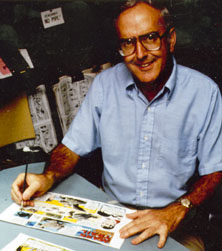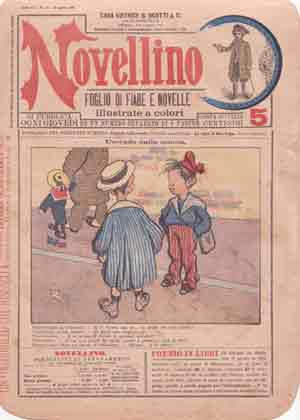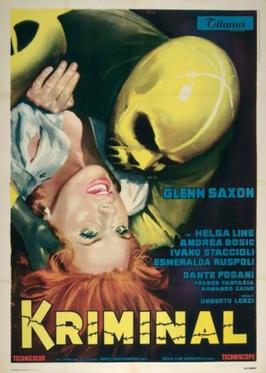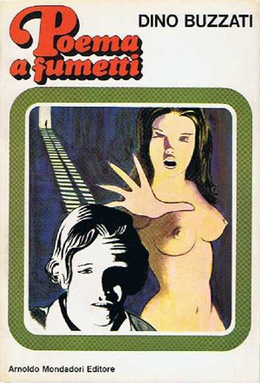| Girighiz | |
|---|---|
 |
Girighiz is an Italian comic strip created by Enzo Lunari.
| Girighiz | |
|---|---|
 |
Girighiz is an Italian comic strip created by Enzo Lunari.
Girighiz first appeared in August 1965, in the comic magazine Linus . [1] [2]
Set in the prehistoric age, the cartoon strip, unlike Johnny Hart's similar BC , is openly political and satirical. [1] [2] [3] [4]

A comic strip is a sequence of cartoons, arranged in interrelated panels to display brief humor or form a narrative, often serialized, with text in balloons and captions. Traditionally, throughout the 20th and into the 21st century, these have been published in newspapers and magazines, with daily horizontal strips printed in black-and-white in newspapers, while Sunday papers offered longer sequences in special color comics sections. With the advent of the internet, online comic strips began to appear as webcomics.

A cartoon is a type of visual art that is typically drawn, frequently animated, in an unrealistic or semi-realistic style. The specific meaning has evolved, but the modern usage usually refers to either: an image or series of images intended for satire, caricature, or humor; or a motion picture that relies on a sequence of illustrations for its animation. Someone who creates cartoons in the first sense is called a cartoonist, and in the second sense they are usually called an animator.

Comics are a medium used to express ideas with images, often combined with text or other visual information. It typically takes the form of a sequence of panels of images. Textual devices such as speech balloons, captions, and onomatopoeia can indicate dialogue, narration, sound effects, or other information. There is no consensus among theorists and historians on a definition of comics; some emphasize the combination of images and text, some sequentiality or other image relations, and others historical aspects such as mass reproduction or the use of recurring characters. Cartooning and other forms of illustration are the most common means of image-making in comics. Photo comics is a form that uses photographic images. Common forms include comic strips, editorial and gag cartoons, and comic books. Since the late 20th century, bound volumes such as graphic novels, comic albums, and tankōbon have become increasingly common, along with webcomics as well as scientific/medical comics.

A cartoonist is a visual artist who specializes in both drawing and writing cartoons or comics. Cartoonists differ from comics writers or comics illustrators/artists in that they produce both the literary and graphic components of the work as part of their practice.

Print syndication distributes news articles, columns, political cartoons, comic strips and other features to newspapers, magazines and websites. The syndicates offer reprint rights and grant permissions to other parties for republishing content of which they own and/or represent copyrights. Other terms for the service include a newspaper syndicate, a press syndicate, and a feature syndicate.

Crazy Magazine is an illustrated satire and humor magazine that was published by Marvel Comics from 1973 to 1983 for a total of 94 regular issues. It was preceded by two standard-format comic books titled Crazy. The magazine's format followed in the tradition of Mad, Sick, Cracked and National Lampoon.

Italian comics, also known as fumetto, plural form fumetti, are comics that originate in Italy. The most popular Italian comics have been translated into many languages. The term fumetto refers to the distinctive word balloons that contain the dialogue in comics.
Manix was both the title and main character of a comic strip serial published in the British comics anthology Eagle. The serial first appeared in issue 24.
The Corriere dei Piccoli, later nicknamed Corrierino, was a weekly magazine for children published in Italy from 1908 to 1995. It was the first Italian periodical to make a regular feature of publishing comic strips.

Photo comics are a form of sequential storytelling using photographs rather than illustrations for the images, along with the usual comics conventions of narrative text and word balloons containing dialogue. They are sometimes referred to in English as fumetti, photonovels, photoromances, and similar terms. The photographs may be of real people in staged scenes, or posed dolls and other toys on sets.

The Billy Ireland Cartoon Library & Museum is a research library of American cartoons and comic art affiliated with the Ohio State University library system in Columbus, Ohio. Formerly known as the Cartoon Research Library and the Cartoon Library & Museum, it holds the world's largest and most comprehensive academic research facility documenting and displaying original and printed comic strips, editorial cartoons, and cartoon art. The museum is named after the Ohio cartoonist Billy Ireland.

Popeye the Sailor is a fictional cartoon character created by Elzie Crisler Segar. The character first appeared on January 17, 1929, in the daily King Features comic strip Thimble Theatre. The strip was in its tenth year when Popeye made his debut, but the one-eyed sailor quickly became the lead character, and Thimble Theatre became one of King Features' most popular properties during the 1930s. Following Segar's death in 1938, Thimble Theatre was continued by several writers and artists, most notably Segar's assistant Bud Sagendorf. The strip continues to appear in first-run installments on Sundays, written and drawn by R. K. Milholland. The daily strips are reprints of old Sagendorf stories.

Comics journalism is a form of journalism that covers news or nonfiction events using the framework of comics, a combination of words and drawn images. Typically, sources are actual people featured in each story, and word balloons are actual quotes. The term "comics journalism" was coined by one of its most notable practitioners, Joe Sacco. Other terms for the practice include "graphic journalism," "comic strip journalism", "cartoon journalism", "cartoon reporting", "comics reportage", "journalistic comics", "sequential reportage," and "sketchbook reports".
Comics has developed specialized terminology. Several attempts have been made to formalize and define the terminology of comics by authors such as Will Eisner, Scott McCloud, R. C. Harvey and Dylan Horrocks. Much of the terminology in English is under dispute, so this page will list and describe the most common terms used in comics.

Nilus is an Italian comic strip created by Agostino and Franco Origone. It is considered among the most famous and successful comic strips ever created in Italy.

Kriminal is a 1966 superhero film directed and written by Umberto Lenzi. The film is about a thief and murderer called Kriminal who escapes from a prison and is chased after by Inspector Milton. It was followed by a sequel, Il marchio di Kriminal.
The International Cartoonists Exhibition, known familiarly as Rapalloonia, is an annual comics festival held in Rapallo, Liguria, Italy.

Poem Strip is a 1969 comic book by the Italian writer and illustrator Dino Buzzati. It retells the myth of Orpheus and Eurydice, set in Milan in the 1960s. The aesthetics are influenced by 1960s pop culture. An English translation by Marina Harss was published in 2009.
A gag-a-day comic strip is the style of writing comic cartoons such that every installment of a strip delivers a complete joke or some other kind of artistic statement. It is opposed to story or continuity strips, which rely on the development of a story line across a sequence of the installments. Most syndicated comics are of this type. Another term for this distinction is non-serial (gag-a-day) vs. serial strips.
Giove Toppi was an Italian cartoonist and the first to draw Mickey Mouse comics in Italy.